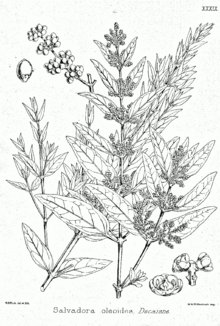Salvadora oleoides
This article needs additional citations for verification. (November 2019) |
| Salvadora oleoides | |
|---|---|

| |
| Scientific classification | |
| Kingdom: | Plantae |
| Clade: | Tracheophytes |
| Clade: | Angiosperms |
| Clade: | Eudicots |
| Clade: | Rosids |
| Order: | Brassicales |
| Family: | Salvadoraceae |
| Genus: | Salvadora |
| Species: | S. oleoides
|
| Binomial name | |
| Salvadora oleoides Decne.[1]
| |
Salvadora oleoides is a small bushy evergreen tree found in India and Pakistan and southern Iran.
Description

It is a small tree with drooping branches, rarely with proper bole or exceeding a height of 20 feet and a girth of 3 feet. It is very common plant in arid tracts but becomes scarce where rainfall conditions are better. It can withstand great soil salinity. It produces new leaves during April, which on maturity become thick and leathery.
The tree coppices fairly well but regenerates freely by root suckers and natural layering. It is, however, very slow growing but a dense growth is often formed around the parent plant by root suckers and some natural seedlings. The plant provides a dense shade. It is often lopped for camel and goat fodder.
Fruit
Small greenish white flowers are produced in March–April. The fruit is yellow and ripens in the months of May and June. It forms one of the main grazing sources for livestock owned by local farmers. It is often dried and preserved in large quantities. The seeds are spread by birds. The seedlings come up under the parent plant or under other bushes and are somewhat frost-tender.
Habitat
The vann is commonly found in and around Sandal Bar, and is reserved for use as grazing sources for local peasant villages. In addition, a number of trees have been preserved to provide shade for cattle.
Wood

The vann is mostly non-woody and the small amount of wood that it has is soft, light, and not particularly useful for any of wood's normal uses, notably building and heat. When burnt, it leaves a large quantity of ash, which can then be boiled down into a substance for treating mange in camels.
In literature
Pilu tree in Mahabharata
The Mahabharata Book VIII: Karna Parva, Chapter 30, verse 24 mentions tree species as Sami, Pilu and Karir tree species as under in Sanskrit and IAST:
- शमी पीलु करीराणां वनेषु सुखवर्त्मसु (śamī pīlu karīrāṇāṃ vaneṣu sukhavartmasu)
- अपूपान सक्तु पिण्डीश च खाथन्तॊ मदितान्विताः (apūpān saktu piṇḍīś ca khādanto mathitānvitāḥ)
- Meaning - "When shall I be amongst those ladies eating cakes of flour and meat and balls of pounded barley mixed with skimmed milk, in the forests, having many pleasant paths of Sami and Pilu and Karira!" (VIII.30.24)
Jal-tree
In the janamsakhis of Guru Nanak, he was found laying under a jal-tree whose shadow remained stationary to protect him from the sun. Macauliffe identifies this tree as Salvadora oleoides.[2]
See also
- Pīlu - Mentioned in Mahābhārata.
- Salvadora persica—Toothbrush tree, peelu, or siwak
References
- ^ "Salvadora oleoides". Germplasm Resources Information Network. Agricultural Research Service, United States Department of Agriculture. Retrieved 2010-08-21.
- ^ Macauliffe, Max Arthur (1909). The Sikh Religion, its gurus, sacred writings and authors. Oxford: Oxford University Press. p. .
- RN Kaul (1963): Need for afforestation in the arid zones of India, LA-YAARAN, Vol 13
- RC Ghosh (1977): Hand book on afforestation techniques, Dehradun.
- RK Gupta & Ishwar Prakasah (1975): Environmental analysis of the Thar Desert, Dehradun.
